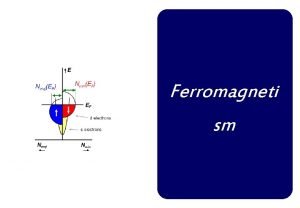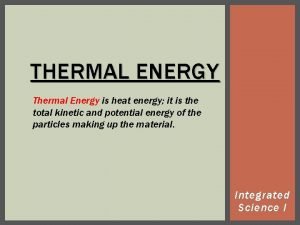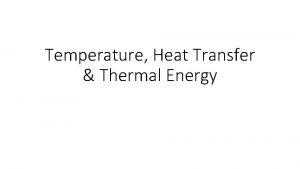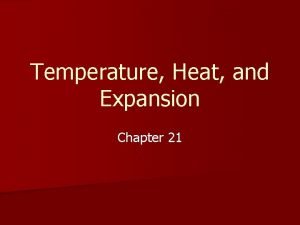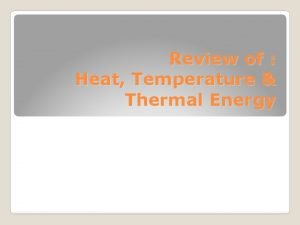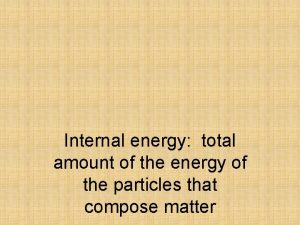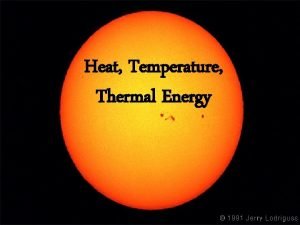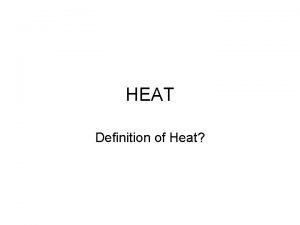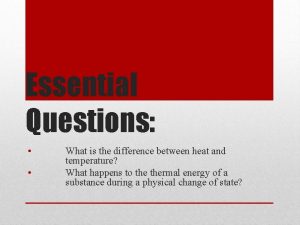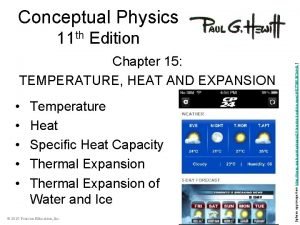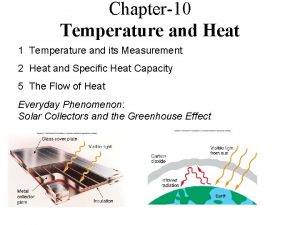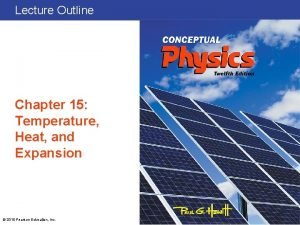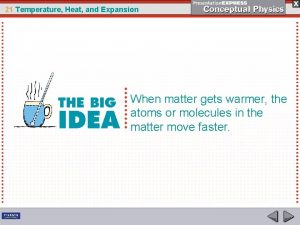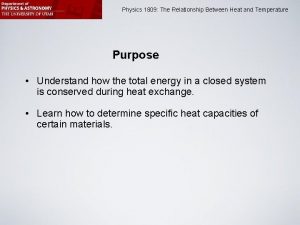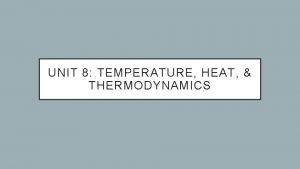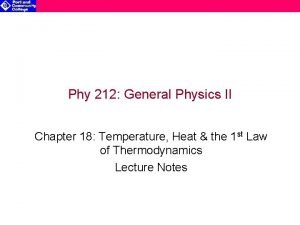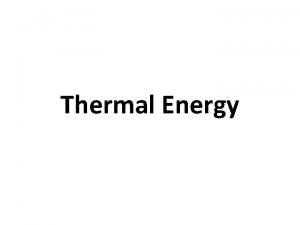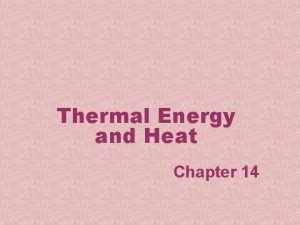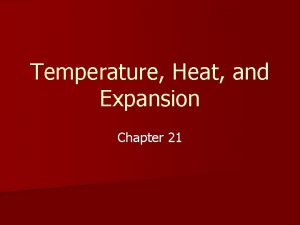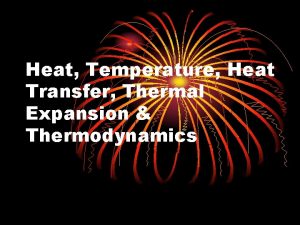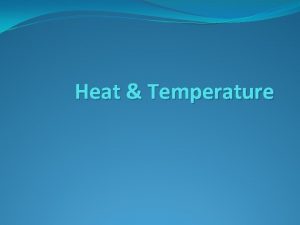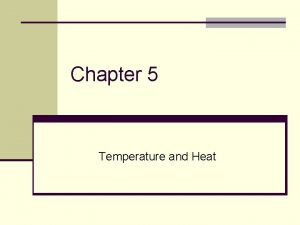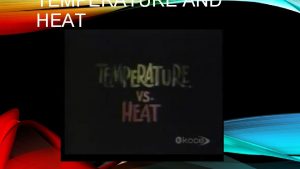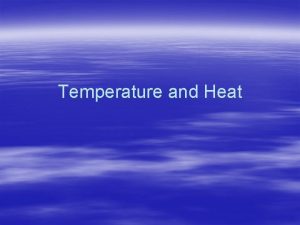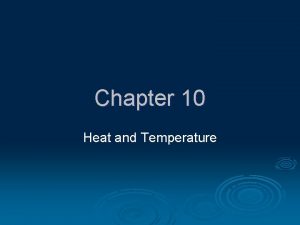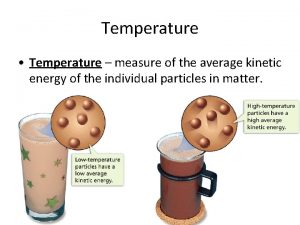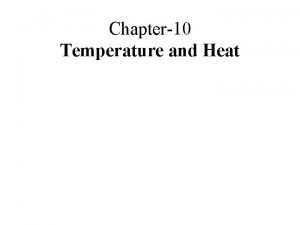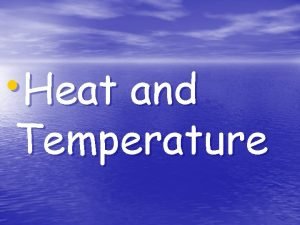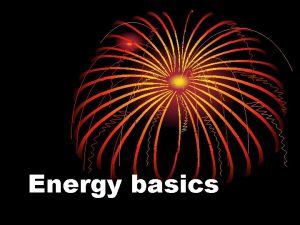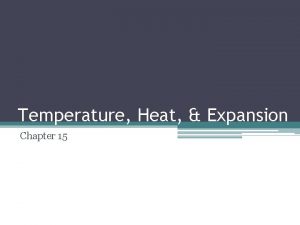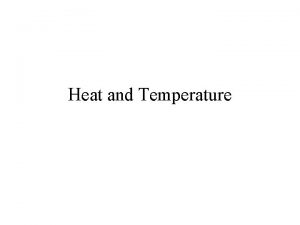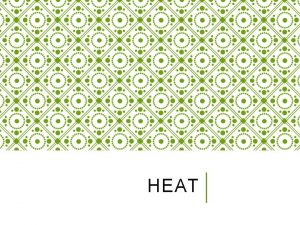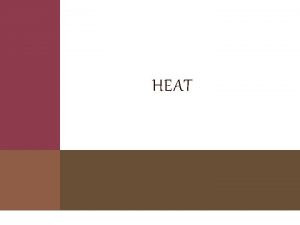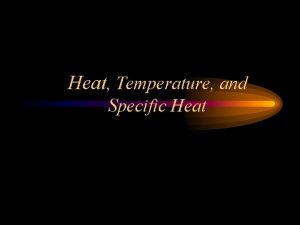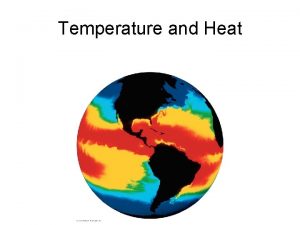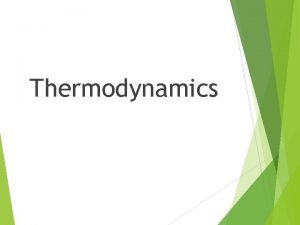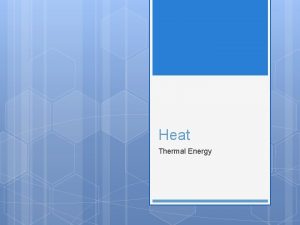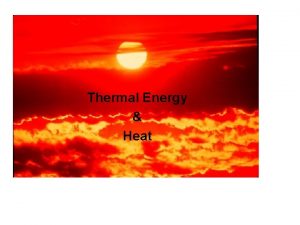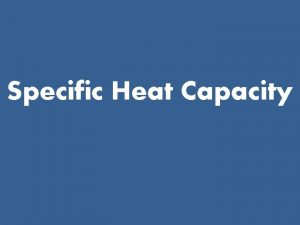Temperature and Heat What are temperature and heat























- Slides: 23

Temperature and Heat

What are temperature and heat? Are they the same? What causes heat?

What Is Temperature? How do we measure temperature? What are we actually measuring?

Temperature and Its Measurement How do we measure temperature? Thermometer: Device with a physical property that changes with temperature and can be easily measured quantitatively. If two objects are in contact with one another long enough, the two objects have the same temperature (thermal equilibrium). Two or more objects in thermal equilibrium have the same temperature. Zeroth law of thermodynamics.

Temperature Scales The first widely used temperature scale was devised by Gabriel Fahrenheit. Water freezing point: 32 F Water boiling point: 212 F Another widely used scale was devised by Anders Celsius. Water freezing point: 0 C. Water boiling point: 100 C

Temperature Scales Conversion between two scales: E 1. An object has a temperature of 45 C. What is its temperature in degree Fahrenheit? E 2. The temperature of a winter day is 14 F. What is the temperature in degree Celsius?

Zero Temperature The zero point on the Fahrenheit scale was based on the temperature of a mixture of salt and ice in a saturated salt solution. The zero point on the Celsius scale is the freezing point of water. Both scales go below zero. Is there an absolute zero?

What is absolute zero? If the volume of a gas is kept constant while the temperature is different, the pressure will be different.

The Third Temperature Scale Absolute Temperature Scale (Kelvin Scale) Example Water freezing point: 0 C =273. 2 K. Water boiling point: 100 C = 373. 2 K

Heat and Specific Heat Capacity l. Steel has a lower specific heat capacity than water.

Specific Heat Capacity specific heat capacity (c): the quantity of heat needed to change a unit mass (1 g) of the material by a unit amount in temperature (1 C ). It is a property of the material, determined by experiment. The specific heat capacity of water is 1 cal/g C Table 10. 1 Specific capacity of some common substances Substance Water Ice Steam Ethyl alcohol Glass Aluminum Specific Heat Capacity (in Cal/g/C ) 1. 0 0. 49 0. 48 0. 58 0. 20 0. 215

When a material’s temperature is changed, we can calculate how much heat absorbed/released by the material: Q = mc T where Q = quantity of heat m = mass c = specific heat capacity T = change in temperature Example: E 6 How much heat is required to raise the temperature of 70 g of water from 20 C to 80 C

Heat and Temperature Heat: Heat is the energy that flows from one object to another when there is a difference in temperature between the objects. Heat is the average kinetic energy of atoms or molecules making up the system. Temperature: Temperature is an indication of whether or not and in which direction, the heat will flow (Temperature is an indication of the average of kinetic energy of atoms or molecules).

Phase Change and Latent Heat When an object goes through a change of phase or state, heat is added or removed without changing the temperature. Instead, the state of matter changes: solid to liquid, for example. The amount of heat needed per unit mass to produce a phase change is called the latent heat (L) The latent heat of fusion of water is 80 cal/g (Lf = 80 cal/g is 80 cal/g): it takes 80 calorie of heat the melt 1 g of ice at 0 C to become water at 0 C. The latent heat of vaporization of water is 540 cal/g (Lv = 540 cal/g): it takes 540 calories of heat to turn one gram of water at 100 C into steam at 100 C.

Example Box 10. 1 If the specific heat capacity of ice is 0. 5 cal/g C°, how much heat would have to be added to 200 g of ice, initially at a temperature of -10°C, to (a) raise the ice to the melting point? (b) complete melt the ice?

Heat and Mechanic Energy Benjamin Thompson (1753 -1814) noticed that cannon barrels and drill bits became hot during drilling. Joule performed a series of experiments showing that mechanical work could raise the temperature of a system. 1 cal = 4. 19 J First law of Thermodynamics. Energy Conservation - In an isolated system, the total amount of energy, including heat, is conserved.

Applying the First Law of Thermodynamics Example (Box 10. 2) : A hot plate is used to transfer 400 cal of heat to a beaker containing ice and water. 500 J of work are also done on the contents of the beaker by stirring. a) What is the increase in internal energy of the ice-water mixture? b) How much ice melts in this process?

Counting Food Calories in Physics and in food: In Physics: 1 calories is the amount of energy needed to raise the temperature of 1 g of water 1 C. In food: 1 Calories is the amount of energy needed to raise the temperature of 1 kg water 1 Cal =1, 000 cal Normal body maintenance uses up about 15 calories per day for each pound of body weight. You must consume about 3500 calories to gain a pound of weight. To burn off 500 calories you would have to run 5 miles, bike 15 miles, or swim for an hour.

The Flow of Heat Three basic processes for heat flow: Conduction Convection Radiation

Conduction: heat flow when in contact The rate of heat flow depends on: a) the temperature difference between the objects. b) thermal conductivity of the materials, a measure of how well the materials conduct heat. A metal block at room temperature will feel colder than a wood block of the exact same temperature. Why?

Convection: heat is transferred by the motion of a fluid containing thermal energy. Radiation, heat energy is transferred by electromagnetic waves. can take place across a vacuum.

What heat-flow processes are involved in the greenhouse effect?

Lab T 4. Measurement of the specific heat Example: Suppose that you have 100 g of water at the temperature of 20 C, and you have 50 g of a metal at the temperature of 100 C. If you put the metal into the water, and the final temperature is 30 C when the mix of water and aluminum reaches a thermal equilibrium, what is the specific capacity of the metal?
 Antigentest åre
Antigentest åre Difference between curie temperature and neel temperature
Difference between curie temperature and neel temperature Difference between curie temperature and neel temperature
Difference between curie temperature and neel temperature Difference between antiferromagnetism and ferrimagnetism
Difference between antiferromagnetism and ferrimagnetism Thermal energy vs heat
Thermal energy vs heat What is heat
What is heat Chapter 21 temperature heat and expansion
Chapter 21 temperature heat and expansion Heat thermal energy and temperature
Heat thermal energy and temperature The difference between heat and temperature
The difference between heat and temperature Thermal energy vs heat
Thermal energy vs heat Heat energy meaning
Heat energy meaning The difference between heat and temperature
The difference between heat and temperature Chapter 15 temperature heat and expansion
Chapter 15 temperature heat and expansion Unit for specific heat
Unit for specific heat Chapter 21 temperature, heat and expansion answer key
Chapter 21 temperature, heat and expansion answer key Solid liquid gas particles
Solid liquid gas particles Relation between heat and temperature
Relation between heat and temperature Physics heat and temperature
Physics heat and temperature Plate type exchanger
Plate type exchanger Physics heat and temperature
Physics heat and temperature Graph of kinetic energy vs temperature
Graph of kinetic energy vs temperature Chapter 14 section 1 heat and temperature answers
Chapter 14 section 1 heat and temperature answers Chapter 21 temperature heat and expansion
Chapter 21 temperature heat and expansion Chapter 21 temperature heat and expansion
Chapter 21 temperature heat and expansion



